Healthcare Leadership: Facilitating Change and Performance Improvement
VerifiedAdded on 2023/04/21
|13
|4157
|162
Essay
AI Summary
This essay critically examines the role of leadership in facilitating change processes and performance improvement strategies within healthcare settings, focusing on increasing handwashing compliance among nurses. It highlights the dangers of ineffective hand hygiene and the necessity for change, referencing Lewin's Change Model and WHO guidelines. The essay emphasizes the importance of leadership skills such as dedication to excellence, communication, critical thinking, and integrity in driving change. It further discusses how nurse leaders can motivate healthcare providers, foster engagement, and ensure loyalty during organizational changes. The nudge theory is mentioned as a strategy to address emotional responses to change, particularly among different workforce demographics. The essay concludes by underscoring the importance of monitoring employee performance to ensure the success of changes within a healthcare organization. Desklib provides access to this essay and a wealth of study tools for students.
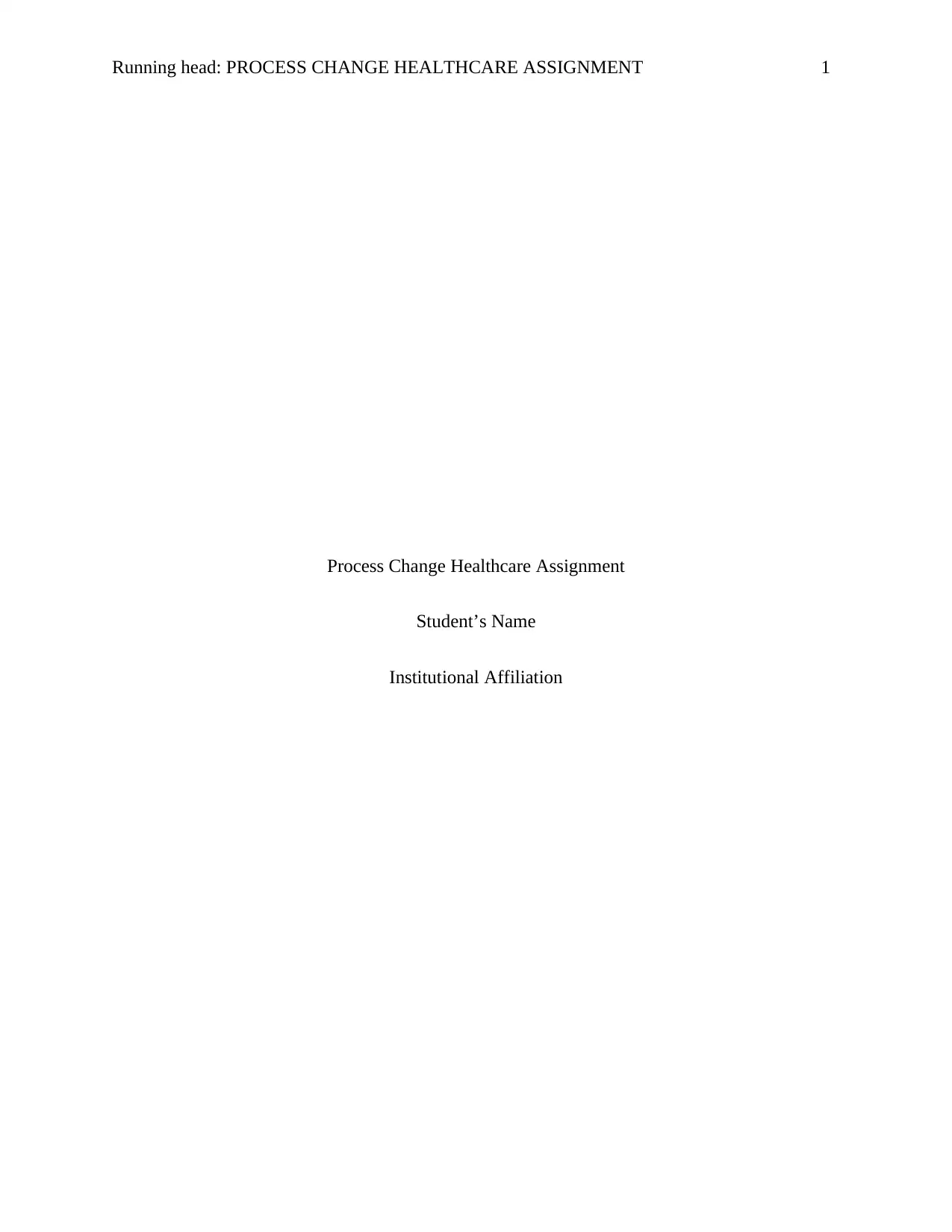
Running head: PROCESS CHANGE HEALTHCARE ASSIGNMENT 1
Process Change Healthcare Assignment
Student’s Name
Institutional Affiliation
Process Change Healthcare Assignment
Student’s Name
Institutional Affiliation
Paraphrase This Document
Need a fresh take? Get an instant paraphrase of this document with our AI Paraphraser
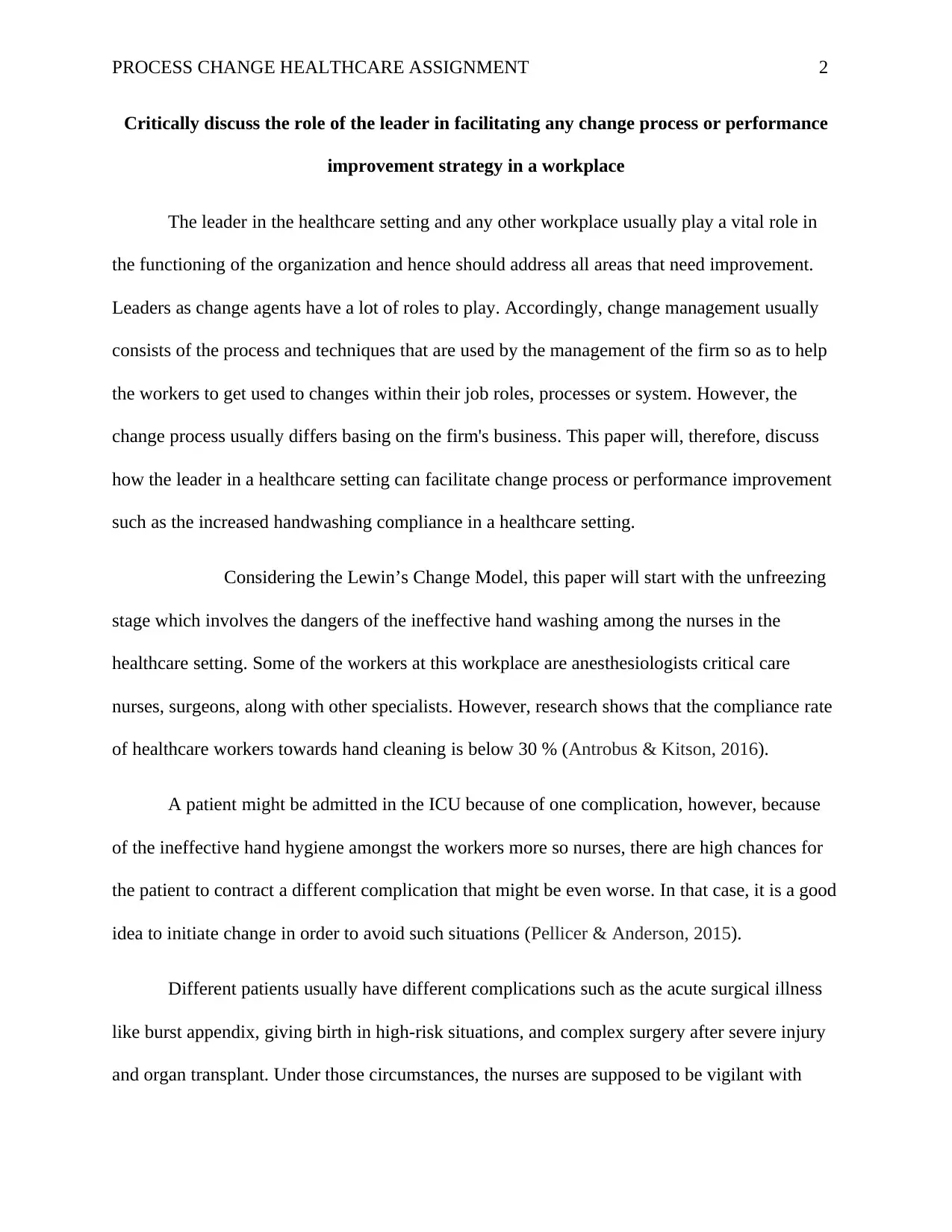
PROCESS CHANGE HEALTHCARE ASSIGNMENT 2
Critically discuss the role of the leader in facilitating any change process or performance
improvement strategy in a workplace
The leader in the healthcare setting and any other workplace usually play a vital role in
the functioning of the organization and hence should address all areas that need improvement.
Leaders as change agents have a lot of roles to play. Accordingly, change management usually
consists of the process and techniques that are used by the management of the firm so as to help
the workers to get used to changes within their job roles, processes or system. However, the
change process usually differs basing on the firm's business. This paper will, therefore, discuss
how the leader in a healthcare setting can facilitate change process or performance improvement
such as the increased handwashing compliance in a healthcare setting.
Considering the Lewin’s Change Model, this paper will start with the unfreezing
stage which involves the dangers of the ineffective hand washing among the nurses in the
healthcare setting. Some of the workers at this workplace are anesthesiologists critical care
nurses, surgeons, along with other specialists. However, research shows that the compliance rate
of healthcare workers towards hand cleaning is below 30 % (Antrobus & Kitson, 2016).
A patient might be admitted in the ICU because of one complication, however, because
of the ineffective hand hygiene amongst the workers more so nurses, there are high chances for
the patient to contract a different complication that might be even worse. In that case, it is a good
idea to initiate change in order to avoid such situations (Pellicer & Anderson, 2015).
Different patients usually have different complications such as the acute surgical illness
like burst appendix, giving birth in high-risk situations, and complex surgery after severe injury
and organ transplant. Under those circumstances, the nurses are supposed to be vigilant with
Critically discuss the role of the leader in facilitating any change process or performance
improvement strategy in a workplace
The leader in the healthcare setting and any other workplace usually play a vital role in
the functioning of the organization and hence should address all areas that need improvement.
Leaders as change agents have a lot of roles to play. Accordingly, change management usually
consists of the process and techniques that are used by the management of the firm so as to help
the workers to get used to changes within their job roles, processes or system. However, the
change process usually differs basing on the firm's business. This paper will, therefore, discuss
how the leader in a healthcare setting can facilitate change process or performance improvement
such as the increased handwashing compliance in a healthcare setting.
Considering the Lewin’s Change Model, this paper will start with the unfreezing
stage which involves the dangers of the ineffective hand washing among the nurses in the
healthcare setting. Some of the workers at this workplace are anesthesiologists critical care
nurses, surgeons, along with other specialists. However, research shows that the compliance rate
of healthcare workers towards hand cleaning is below 30 % (Antrobus & Kitson, 2016).
A patient might be admitted in the ICU because of one complication, however, because
of the ineffective hand hygiene amongst the workers more so nurses, there are high chances for
the patient to contract a different complication that might be even worse. In that case, it is a good
idea to initiate change in order to avoid such situations (Pellicer & Anderson, 2015).
Different patients usually have different complications such as the acute surgical illness
like burst appendix, giving birth in high-risk situations, and complex surgery after severe injury
and organ transplant. Under those circumstances, the nurses are supposed to be vigilant with
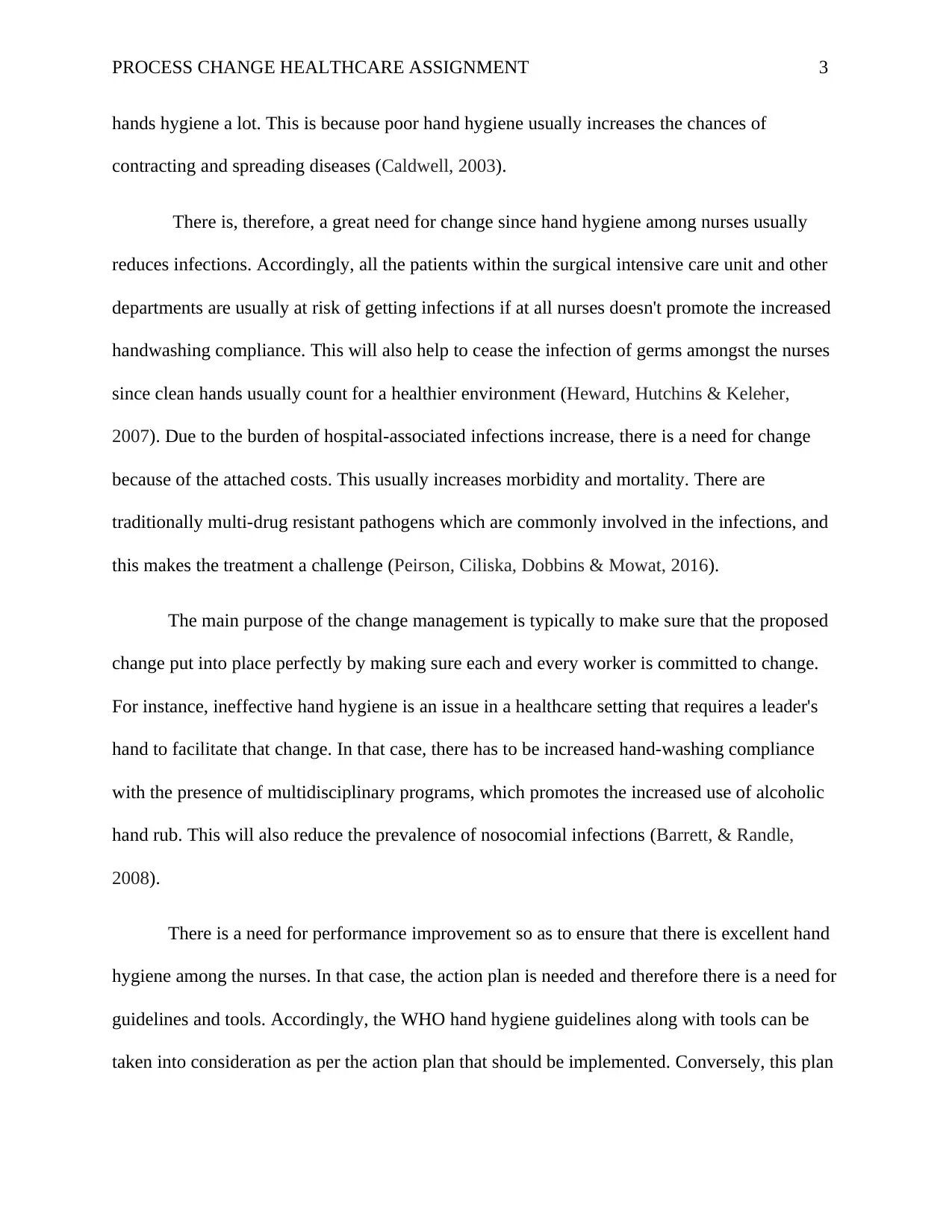
PROCESS CHANGE HEALTHCARE ASSIGNMENT 3
hands hygiene a lot. This is because poor hand hygiene usually increases the chances of
contracting and spreading diseases (Caldwell, 2003).
There is, therefore, a great need for change since hand hygiene among nurses usually
reduces infections. Accordingly, all the patients within the surgical intensive care unit and other
departments are usually at risk of getting infections if at all nurses doesn't promote the increased
handwashing compliance. This will also help to cease the infection of germs amongst the nurses
since clean hands usually count for a healthier environment (Heward, Hutchins & Keleher,
2007). Due to the burden of hospital-associated infections increase, there is a need for change
because of the attached costs. This usually increases morbidity and mortality. There are
traditionally multi-drug resistant pathogens which are commonly involved in the infections, and
this makes the treatment a challenge (Peirson, Ciliska, Dobbins & Mowat, 2016).
The main purpose of the change management is typically to make sure that the proposed
change put into place perfectly by making sure each and every worker is committed to change.
For instance, ineffective hand hygiene is an issue in a healthcare setting that requires a leader's
hand to facilitate that change. In that case, there has to be increased hand-washing compliance
with the presence of multidisciplinary programs, which promotes the increased use of alcoholic
hand rub. This will also reduce the prevalence of nosocomial infections (Barrett, & Randle,
2008).
There is a need for performance improvement so as to ensure that there is excellent hand
hygiene among the nurses. In that case, the action plan is needed and therefore there is a need for
guidelines and tools. Accordingly, the WHO hand hygiene guidelines along with tools can be
taken into consideration as per the action plan that should be implemented. Conversely, this plan
hands hygiene a lot. This is because poor hand hygiene usually increases the chances of
contracting and spreading diseases (Caldwell, 2003).
There is, therefore, a great need for change since hand hygiene among nurses usually
reduces infections. Accordingly, all the patients within the surgical intensive care unit and other
departments are usually at risk of getting infections if at all nurses doesn't promote the increased
handwashing compliance. This will also help to cease the infection of germs amongst the nurses
since clean hands usually count for a healthier environment (Heward, Hutchins & Keleher,
2007). Due to the burden of hospital-associated infections increase, there is a need for change
because of the attached costs. This usually increases morbidity and mortality. There are
traditionally multi-drug resistant pathogens which are commonly involved in the infections, and
this makes the treatment a challenge (Peirson, Ciliska, Dobbins & Mowat, 2016).
The main purpose of the change management is typically to make sure that the proposed
change put into place perfectly by making sure each and every worker is committed to change.
For instance, ineffective hand hygiene is an issue in a healthcare setting that requires a leader's
hand to facilitate that change. In that case, there has to be increased hand-washing compliance
with the presence of multidisciplinary programs, which promotes the increased use of alcoholic
hand rub. This will also reduce the prevalence of nosocomial infections (Barrett, & Randle,
2008).
There is a need for performance improvement so as to ensure that there is excellent hand
hygiene among the nurses. In that case, the action plan is needed and therefore there is a need for
guidelines and tools. Accordingly, the WHO hand hygiene guidelines along with tools can be
taken into consideration as per the action plan that should be implemented. Conversely, this plan
⊘ This is a preview!⊘
Do you want full access?
Subscribe today to unlock all pages.

Trusted by 1+ million students worldwide
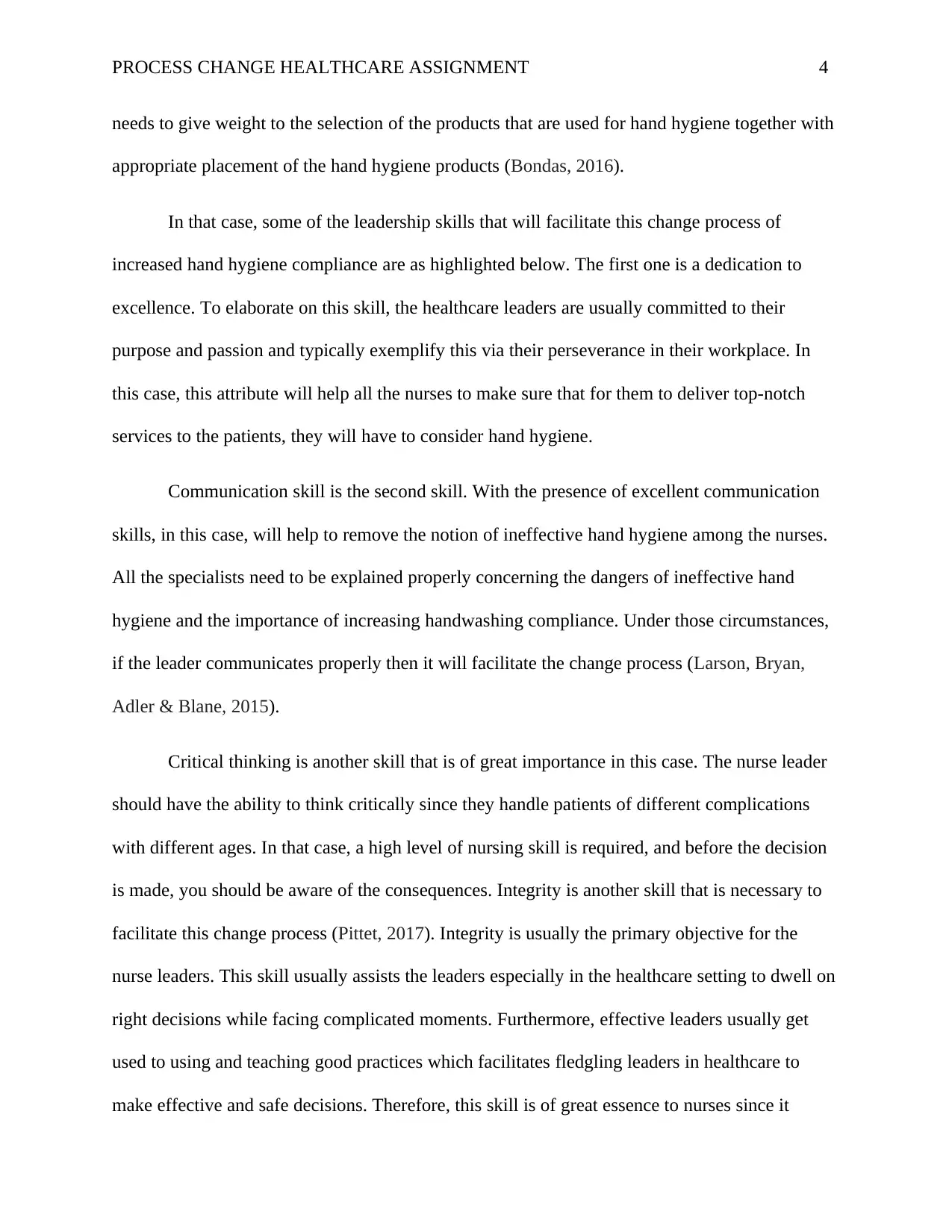
PROCESS CHANGE HEALTHCARE ASSIGNMENT 4
needs to give weight to the selection of the products that are used for hand hygiene together with
appropriate placement of the hand hygiene products (Bondas, 2016).
In that case, some of the leadership skills that will facilitate this change process of
increased hand hygiene compliance are as highlighted below. The first one is a dedication to
excellence. To elaborate on this skill, the healthcare leaders are usually committed to their
purpose and passion and typically exemplify this via their perseverance in their workplace. In
this case, this attribute will help all the nurses to make sure that for them to deliver top-notch
services to the patients, they will have to consider hand hygiene.
Communication skill is the second skill. With the presence of excellent communication
skills, in this case, will help to remove the notion of ineffective hand hygiene among the nurses.
All the specialists need to be explained properly concerning the dangers of ineffective hand
hygiene and the importance of increasing handwashing compliance. Under those circumstances,
if the leader communicates properly then it will facilitate the change process (Larson, Bryan,
Adler & Blane, 2015).
Critical thinking is another skill that is of great importance in this case. The nurse leader
should have the ability to think critically since they handle patients of different complications
with different ages. In that case, a high level of nursing skill is required, and before the decision
is made, you should be aware of the consequences. Integrity is another skill that is necessary to
facilitate this change process (Pittet, 2017). Integrity is usually the primary objective for the
nurse leaders. This skill usually assists the leaders especially in the healthcare setting to dwell on
right decisions while facing complicated moments. Furthermore, effective leaders usually get
used to using and teaching good practices which facilitates fledgling leaders in healthcare to
make effective and safe decisions. Therefore, this skill is of great essence to nurses since it
needs to give weight to the selection of the products that are used for hand hygiene together with
appropriate placement of the hand hygiene products (Bondas, 2016).
In that case, some of the leadership skills that will facilitate this change process of
increased hand hygiene compliance are as highlighted below. The first one is a dedication to
excellence. To elaborate on this skill, the healthcare leaders are usually committed to their
purpose and passion and typically exemplify this via their perseverance in their workplace. In
this case, this attribute will help all the nurses to make sure that for them to deliver top-notch
services to the patients, they will have to consider hand hygiene.
Communication skill is the second skill. With the presence of excellent communication
skills, in this case, will help to remove the notion of ineffective hand hygiene among the nurses.
All the specialists need to be explained properly concerning the dangers of ineffective hand
hygiene and the importance of increasing handwashing compliance. Under those circumstances,
if the leader communicates properly then it will facilitate the change process (Larson, Bryan,
Adler & Blane, 2015).
Critical thinking is another skill that is of great importance in this case. The nurse leader
should have the ability to think critically since they handle patients of different complications
with different ages. In that case, a high level of nursing skill is required, and before the decision
is made, you should be aware of the consequences. Integrity is another skill that is necessary to
facilitate this change process (Pittet, 2017). Integrity is usually the primary objective for the
nurse leaders. This skill usually assists the leaders especially in the healthcare setting to dwell on
right decisions while facing complicated moments. Furthermore, effective leaders usually get
used to using and teaching good practices which facilitates fledgling leaders in healthcare to
make effective and safe decisions. Therefore, this skill is of great essence to nurses since it
Paraphrase This Document
Need a fresh take? Get an instant paraphrase of this document with our AI Paraphraser
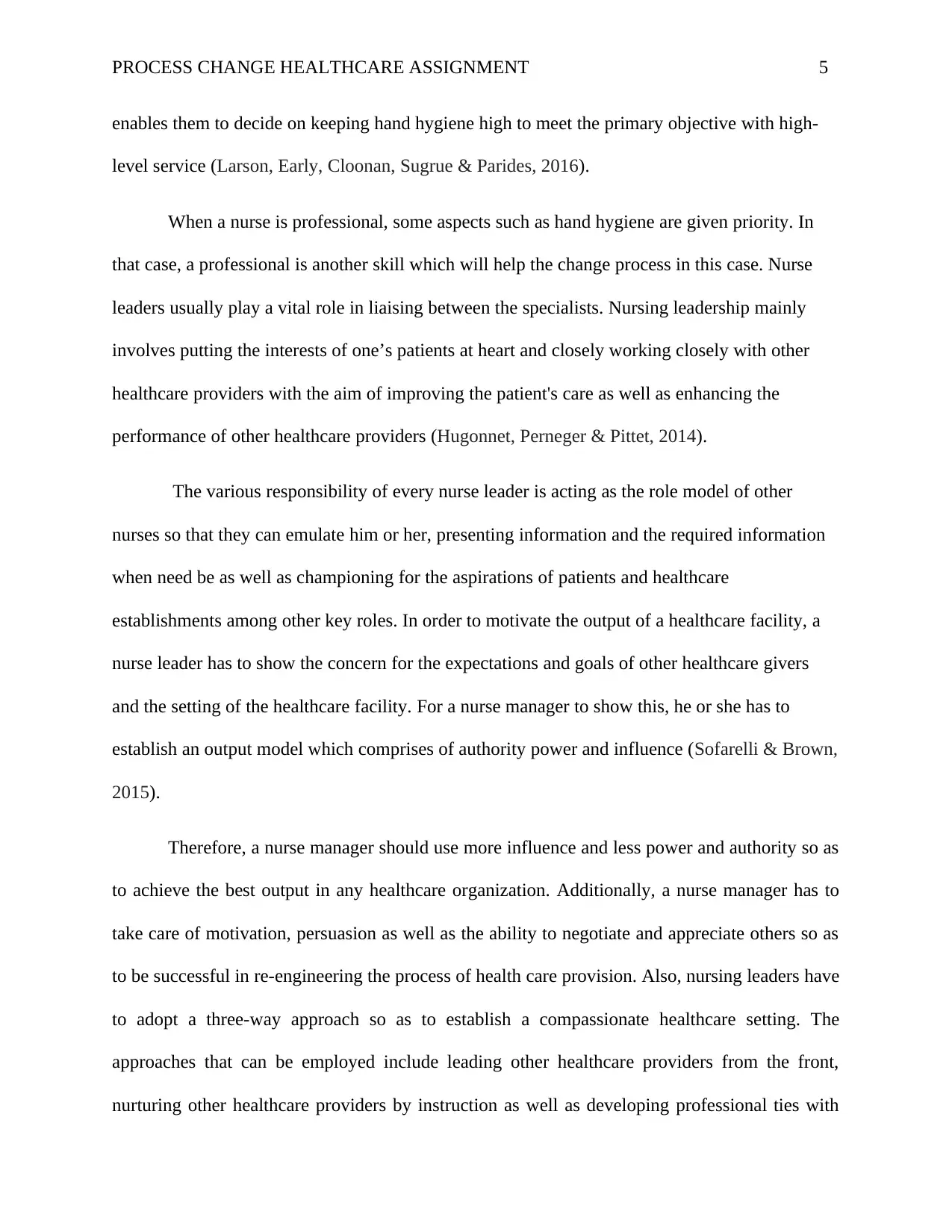
PROCESS CHANGE HEALTHCARE ASSIGNMENT 5
enables them to decide on keeping hand hygiene high to meet the primary objective with high-
level service (Larson, Early, Cloonan, Sugrue & Parides, 2016).
When a nurse is professional, some aspects such as hand hygiene are given priority. In
that case, a professional is another skill which will help the change process in this case. Nurse
leaders usually play a vital role in liaising between the specialists. Nursing leadership mainly
involves putting the interests of one’s patients at heart and closely working closely with other
healthcare providers with the aim of improving the patient's care as well as enhancing the
performance of other healthcare providers (Hugonnet, Perneger & Pittet, 2014).
The various responsibility of every nurse leader is acting as the role model of other
nurses so that they can emulate him or her, presenting information and the required information
when need be as well as championing for the aspirations of patients and healthcare
establishments among other key roles. In order to motivate the output of a healthcare facility, a
nurse leader has to show the concern for the expectations and goals of other healthcare givers
and the setting of the healthcare facility. For a nurse manager to show this, he or she has to
establish an output model which comprises of authority power and influence (Sofarelli & Brown,
2015).
Therefore, a nurse manager should use more influence and less power and authority so as
to achieve the best output in any healthcare organization. Additionally, a nurse manager has to
take care of motivation, persuasion as well as the ability to negotiate and appreciate others so as
to be successful in re-engineering the process of health care provision. Also, nursing leaders have
to adopt a three-way approach so as to establish a compassionate healthcare setting. The
approaches that can be employed include leading other healthcare providers from the front,
nurturing other healthcare providers by instruction as well as developing professional ties with
enables them to decide on keeping hand hygiene high to meet the primary objective with high-
level service (Larson, Early, Cloonan, Sugrue & Parides, 2016).
When a nurse is professional, some aspects such as hand hygiene are given priority. In
that case, a professional is another skill which will help the change process in this case. Nurse
leaders usually play a vital role in liaising between the specialists. Nursing leadership mainly
involves putting the interests of one’s patients at heart and closely working closely with other
healthcare providers with the aim of improving the patient's care as well as enhancing the
performance of other healthcare providers (Hugonnet, Perneger & Pittet, 2014).
The various responsibility of every nurse leader is acting as the role model of other
nurses so that they can emulate him or her, presenting information and the required information
when need be as well as championing for the aspirations of patients and healthcare
establishments among other key roles. In order to motivate the output of a healthcare facility, a
nurse leader has to show the concern for the expectations and goals of other healthcare givers
and the setting of the healthcare facility. For a nurse manager to show this, he or she has to
establish an output model which comprises of authority power and influence (Sofarelli & Brown,
2015).
Therefore, a nurse manager should use more influence and less power and authority so as
to achieve the best output in any healthcare organization. Additionally, a nurse manager has to
take care of motivation, persuasion as well as the ability to negotiate and appreciate others so as
to be successful in re-engineering the process of health care provision. Also, nursing leaders have
to adopt a three-way approach so as to establish a compassionate healthcare setting. The
approaches that can be employed include leading other healthcare providers from the front,
nurturing other healthcare providers by instruction as well as developing professional ties with
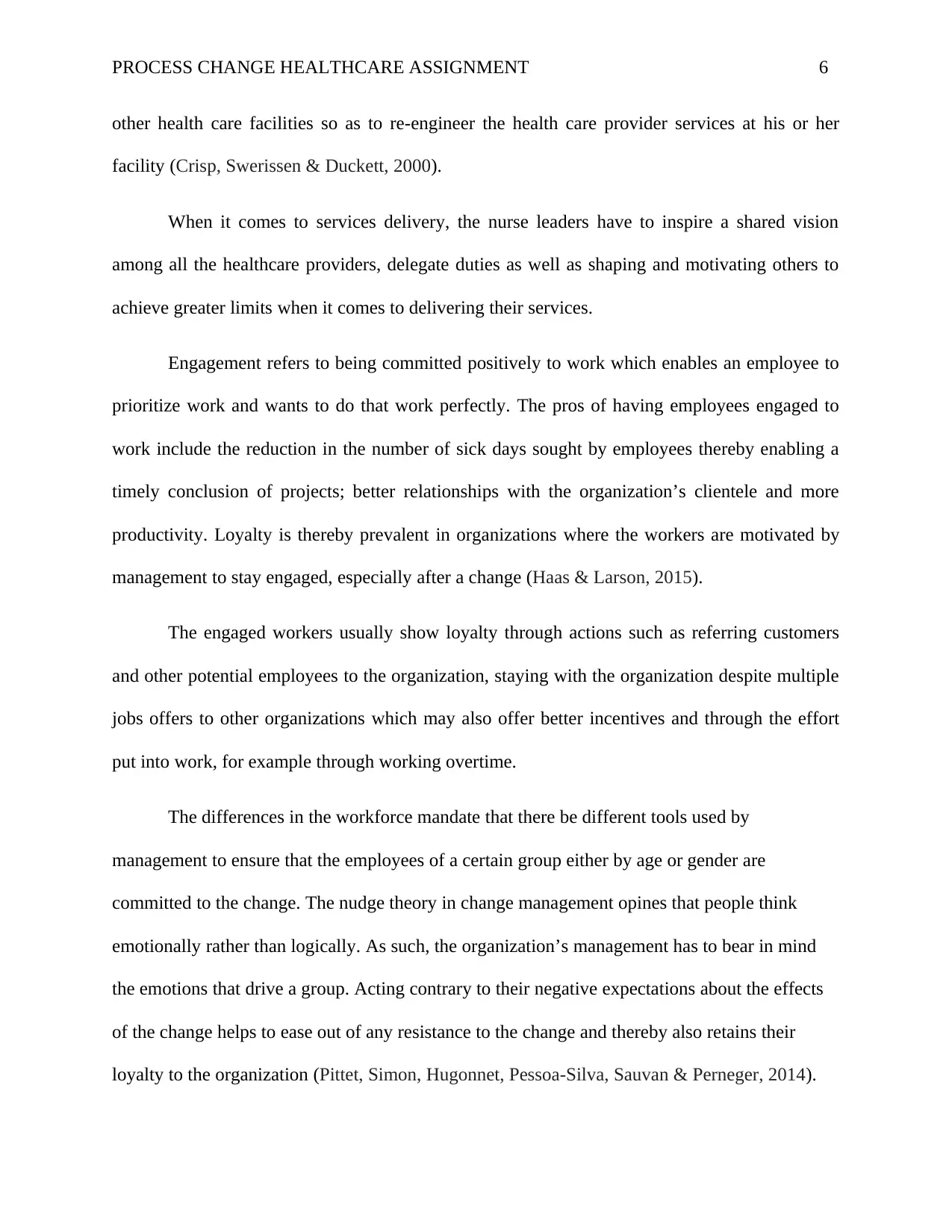
PROCESS CHANGE HEALTHCARE ASSIGNMENT 6
other health care facilities so as to re-engineer the health care provider services at his or her
facility (Crisp, Swerissen & Duckett, 2000).
When it comes to services delivery, the nurse leaders have to inspire a shared vision
among all the healthcare providers, delegate duties as well as shaping and motivating others to
achieve greater limits when it comes to delivering their services.
Engagement refers to being committed positively to work which enables an employee to
prioritize work and wants to do that work perfectly. The pros of having employees engaged to
work include the reduction in the number of sick days sought by employees thereby enabling a
timely conclusion of projects; better relationships with the organization’s clientele and more
productivity. Loyalty is thereby prevalent in organizations where the workers are motivated by
management to stay engaged, especially after a change (Haas & Larson, 2015).
The engaged workers usually show loyalty through actions such as referring customers
and other potential employees to the organization, staying with the organization despite multiple
jobs offers to other organizations which may also offer better incentives and through the effort
put into work, for example through working overtime.
The differences in the workforce mandate that there be different tools used by
management to ensure that the employees of a certain group either by age or gender are
committed to the change. The nudge theory in change management opines that people think
emotionally rather than logically. As such, the organization’s management has to bear in mind
the emotions that drive a group. Acting contrary to their negative expectations about the effects
of the change helps to ease out of any resistance to the change and thereby also retains their
loyalty to the organization (Pittet, Simon, Hugonnet, Pessoa-Silva, Sauvan & Perneger, 2014).
other health care facilities so as to re-engineer the health care provider services at his or her
facility (Crisp, Swerissen & Duckett, 2000).
When it comes to services delivery, the nurse leaders have to inspire a shared vision
among all the healthcare providers, delegate duties as well as shaping and motivating others to
achieve greater limits when it comes to delivering their services.
Engagement refers to being committed positively to work which enables an employee to
prioritize work and wants to do that work perfectly. The pros of having employees engaged to
work include the reduction in the number of sick days sought by employees thereby enabling a
timely conclusion of projects; better relationships with the organization’s clientele and more
productivity. Loyalty is thereby prevalent in organizations where the workers are motivated by
management to stay engaged, especially after a change (Haas & Larson, 2015).
The engaged workers usually show loyalty through actions such as referring customers
and other potential employees to the organization, staying with the organization despite multiple
jobs offers to other organizations which may also offer better incentives and through the effort
put into work, for example through working overtime.
The differences in the workforce mandate that there be different tools used by
management to ensure that the employees of a certain group either by age or gender are
committed to the change. The nudge theory in change management opines that people think
emotionally rather than logically. As such, the organization’s management has to bear in mind
the emotions that drive a group. Acting contrary to their negative expectations about the effects
of the change helps to ease out of any resistance to the change and thereby also retains their
loyalty to the organization (Pittet, Simon, Hugonnet, Pessoa-Silva, Sauvan & Perneger, 2014).
⊘ This is a preview!⊘
Do you want full access?
Subscribe today to unlock all pages.

Trusted by 1+ million students worldwide
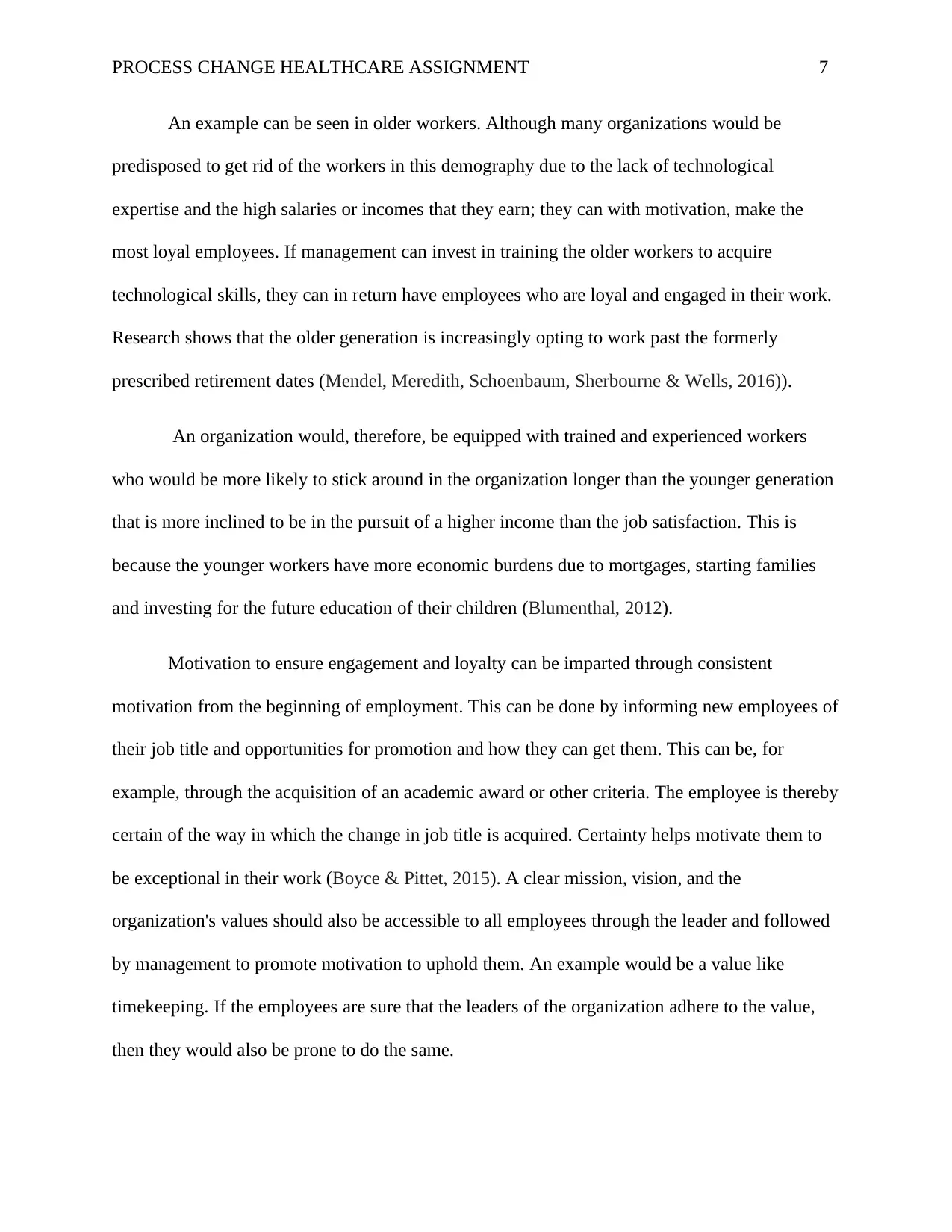
PROCESS CHANGE HEALTHCARE ASSIGNMENT 7
An example can be seen in older workers. Although many organizations would be
predisposed to get rid of the workers in this demography due to the lack of technological
expertise and the high salaries or incomes that they earn; they can with motivation, make the
most loyal employees. If management can invest in training the older workers to acquire
technological skills, they can in return have employees who are loyal and engaged in their work.
Research shows that the older generation is increasingly opting to work past the formerly
prescribed retirement dates (Mendel, Meredith, Schoenbaum, Sherbourne & Wells, 2016)).
An organization would, therefore, be equipped with trained and experienced workers
who would be more likely to stick around in the organization longer than the younger generation
that is more inclined to be in the pursuit of a higher income than the job satisfaction. This is
because the younger workers have more economic burdens due to mortgages, starting families
and investing for the future education of their children (Blumenthal, 2012).
Motivation to ensure engagement and loyalty can be imparted through consistent
motivation from the beginning of employment. This can be done by informing new employees of
their job title and opportunities for promotion and how they can get them. This can be, for
example, through the acquisition of an academic award or other criteria. The employee is thereby
certain of the way in which the change in job title is acquired. Certainty helps motivate them to
be exceptional in their work (Boyce & Pittet, 2015). A clear mission, vision, and the
organization's values should also be accessible to all employees through the leader and followed
by management to promote motivation to uphold them. An example would be a value like
timekeeping. If the employees are sure that the leaders of the organization adhere to the value,
then they would also be prone to do the same.
An example can be seen in older workers. Although many organizations would be
predisposed to get rid of the workers in this demography due to the lack of technological
expertise and the high salaries or incomes that they earn; they can with motivation, make the
most loyal employees. If management can invest in training the older workers to acquire
technological skills, they can in return have employees who are loyal and engaged in their work.
Research shows that the older generation is increasingly opting to work past the formerly
prescribed retirement dates (Mendel, Meredith, Schoenbaum, Sherbourne & Wells, 2016)).
An organization would, therefore, be equipped with trained and experienced workers
who would be more likely to stick around in the organization longer than the younger generation
that is more inclined to be in the pursuit of a higher income than the job satisfaction. This is
because the younger workers have more economic burdens due to mortgages, starting families
and investing for the future education of their children (Blumenthal, 2012).
Motivation to ensure engagement and loyalty can be imparted through consistent
motivation from the beginning of employment. This can be done by informing new employees of
their job title and opportunities for promotion and how they can get them. This can be, for
example, through the acquisition of an academic award or other criteria. The employee is thereby
certain of the way in which the change in job title is acquired. Certainty helps motivate them to
be exceptional in their work (Boyce & Pittet, 2015). A clear mission, vision, and the
organization's values should also be accessible to all employees through the leader and followed
by management to promote motivation to uphold them. An example would be a value like
timekeeping. If the employees are sure that the leaders of the organization adhere to the value,
then they would also be prone to do the same.
Paraphrase This Document
Need a fresh take? Get an instant paraphrase of this document with our AI Paraphraser
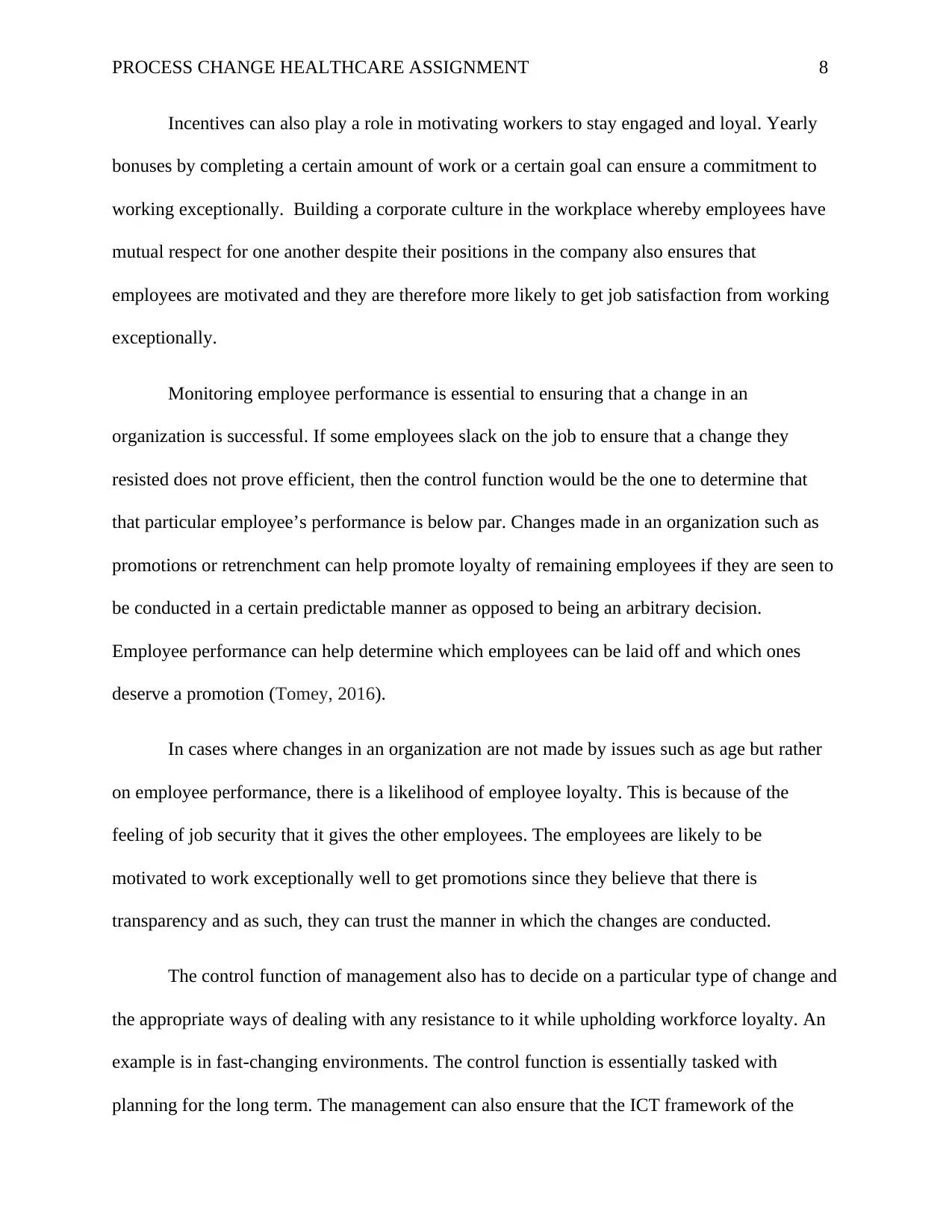
PROCESS CHANGE HEALTHCARE ASSIGNMENT 8
Incentives can also play a role in motivating workers to stay engaged and loyal. Yearly
bonuses by completing a certain amount of work or a certain goal can ensure a commitment to
working exceptionally. Building a corporate culture in the workplace whereby employees have
mutual respect for one another despite their positions in the company also ensures that
employees are motivated and they are therefore more likely to get job satisfaction from working
exceptionally.
Monitoring employee performance is essential to ensuring that a change in an
organization is successful. If some employees slack on the job to ensure that a change they
resisted does not prove efficient, then the control function would be the one to determine that
that particular employee’s performance is below par. Changes made in an organization such as
promotions or retrenchment can help promote loyalty of remaining employees if they are seen to
be conducted in a certain predictable manner as opposed to being an arbitrary decision.
Employee performance can help determine which employees can be laid off and which ones
deserve a promotion (Tomey, 2016).
In cases where changes in an organization are not made by issues such as age but rather
on employee performance, there is a likelihood of employee loyalty. This is because of the
feeling of job security that it gives the other employees. The employees are likely to be
motivated to work exceptionally well to get promotions since they believe that there is
transparency and as such, they can trust the manner in which the changes are conducted.
The control function of management also has to decide on a particular type of change and
the appropriate ways of dealing with any resistance to it while upholding workforce loyalty. An
example is in fast-changing environments. The control function is essentially tasked with
planning for the long term. The management can also ensure that the ICT framework of the
Incentives can also play a role in motivating workers to stay engaged and loyal. Yearly
bonuses by completing a certain amount of work or a certain goal can ensure a commitment to
working exceptionally. Building a corporate culture in the workplace whereby employees have
mutual respect for one another despite their positions in the company also ensures that
employees are motivated and they are therefore more likely to get job satisfaction from working
exceptionally.
Monitoring employee performance is essential to ensuring that a change in an
organization is successful. If some employees slack on the job to ensure that a change they
resisted does not prove efficient, then the control function would be the one to determine that
that particular employee’s performance is below par. Changes made in an organization such as
promotions or retrenchment can help promote loyalty of remaining employees if they are seen to
be conducted in a certain predictable manner as opposed to being an arbitrary decision.
Employee performance can help determine which employees can be laid off and which ones
deserve a promotion (Tomey, 2016).
In cases where changes in an organization are not made by issues such as age but rather
on employee performance, there is a likelihood of employee loyalty. This is because of the
feeling of job security that it gives the other employees. The employees are likely to be
motivated to work exceptionally well to get promotions since they believe that there is
transparency and as such, they can trust the manner in which the changes are conducted.
The control function of management also has to decide on a particular type of change and
the appropriate ways of dealing with any resistance to it while upholding workforce loyalty. An
example is in fast-changing environments. The control function is essentially tasked with
planning for the long term. The management can also ensure that the ICT framework of the
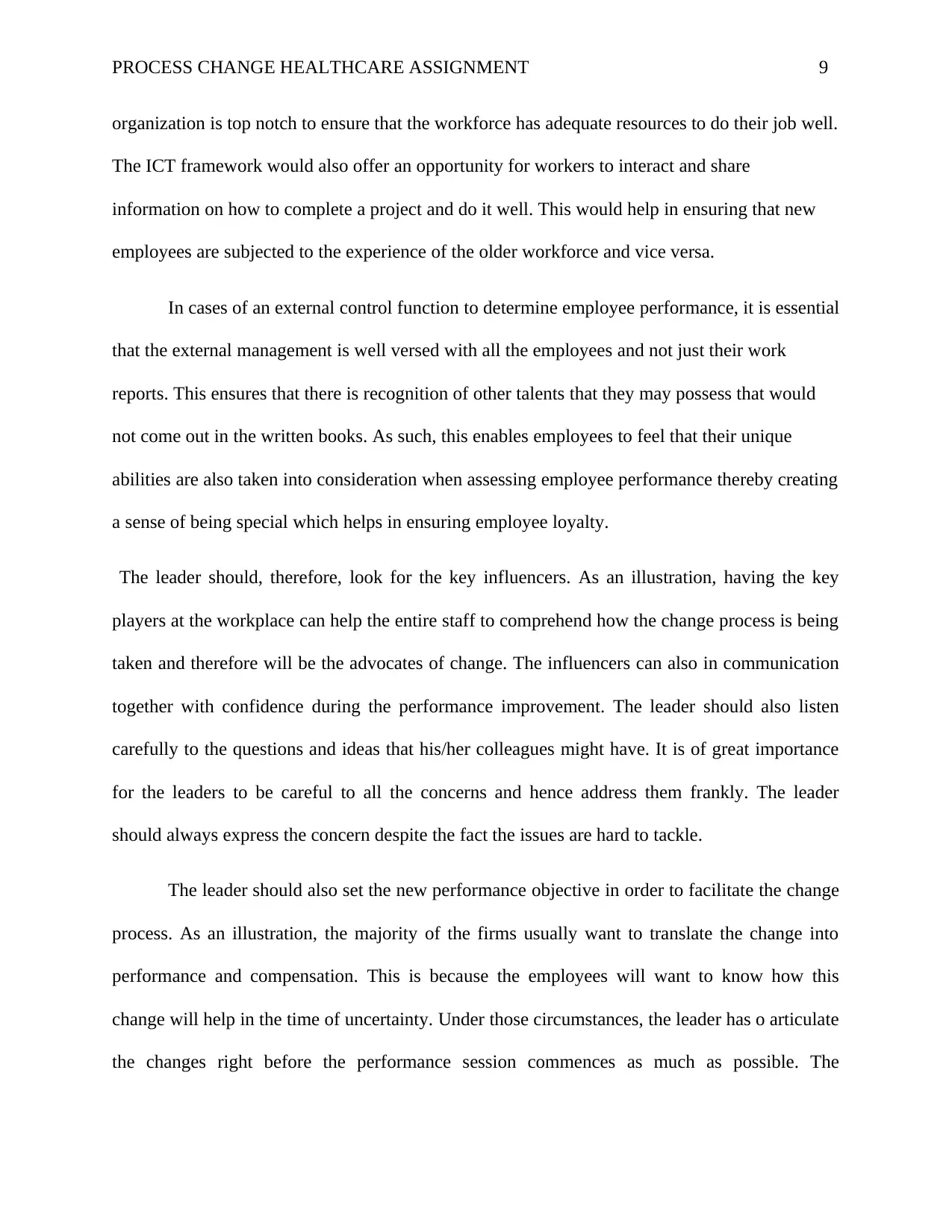
PROCESS CHANGE HEALTHCARE ASSIGNMENT 9
organization is top notch to ensure that the workforce has adequate resources to do their job well.
The ICT framework would also offer an opportunity for workers to interact and share
information on how to complete a project and do it well. This would help in ensuring that new
employees are subjected to the experience of the older workforce and vice versa.
In cases of an external control function to determine employee performance, it is essential
that the external management is well versed with all the employees and not just their work
reports. This ensures that there is recognition of other talents that they may possess that would
not come out in the written books. As such, this enables employees to feel that their unique
abilities are also taken into consideration when assessing employee performance thereby creating
a sense of being special which helps in ensuring employee loyalty.
The leader should, therefore, look for the key influencers. As an illustration, having the key
players at the workplace can help the entire staff to comprehend how the change process is being
taken and therefore will be the advocates of change. The influencers can also in communication
together with confidence during the performance improvement. The leader should also listen
carefully to the questions and ideas that his/her colleagues might have. It is of great importance
for the leaders to be careful to all the concerns and hence address them frankly. The leader
should always express the concern despite the fact the issues are hard to tackle.
The leader should also set the new performance objective in order to facilitate the change
process. As an illustration, the majority of the firms usually want to translate the change into
performance and compensation. This is because the employees will want to know how this
change will help in the time of uncertainty. Under those circumstances, the leader has o articulate
the changes right before the performance session commences as much as possible. The
organization is top notch to ensure that the workforce has adequate resources to do their job well.
The ICT framework would also offer an opportunity for workers to interact and share
information on how to complete a project and do it well. This would help in ensuring that new
employees are subjected to the experience of the older workforce and vice versa.
In cases of an external control function to determine employee performance, it is essential
that the external management is well versed with all the employees and not just their work
reports. This ensures that there is recognition of other talents that they may possess that would
not come out in the written books. As such, this enables employees to feel that their unique
abilities are also taken into consideration when assessing employee performance thereby creating
a sense of being special which helps in ensuring employee loyalty.
The leader should, therefore, look for the key influencers. As an illustration, having the key
players at the workplace can help the entire staff to comprehend how the change process is being
taken and therefore will be the advocates of change. The influencers can also in communication
together with confidence during the performance improvement. The leader should also listen
carefully to the questions and ideas that his/her colleagues might have. It is of great importance
for the leaders to be careful to all the concerns and hence address them frankly. The leader
should always express the concern despite the fact the issues are hard to tackle.
The leader should also set the new performance objective in order to facilitate the change
process. As an illustration, the majority of the firms usually want to translate the change into
performance and compensation. This is because the employees will want to know how this
change will help in the time of uncertainty. Under those circumstances, the leader has o articulate
the changes right before the performance session commences as much as possible. The
⊘ This is a preview!⊘
Do you want full access?
Subscribe today to unlock all pages.

Trusted by 1+ million students worldwide
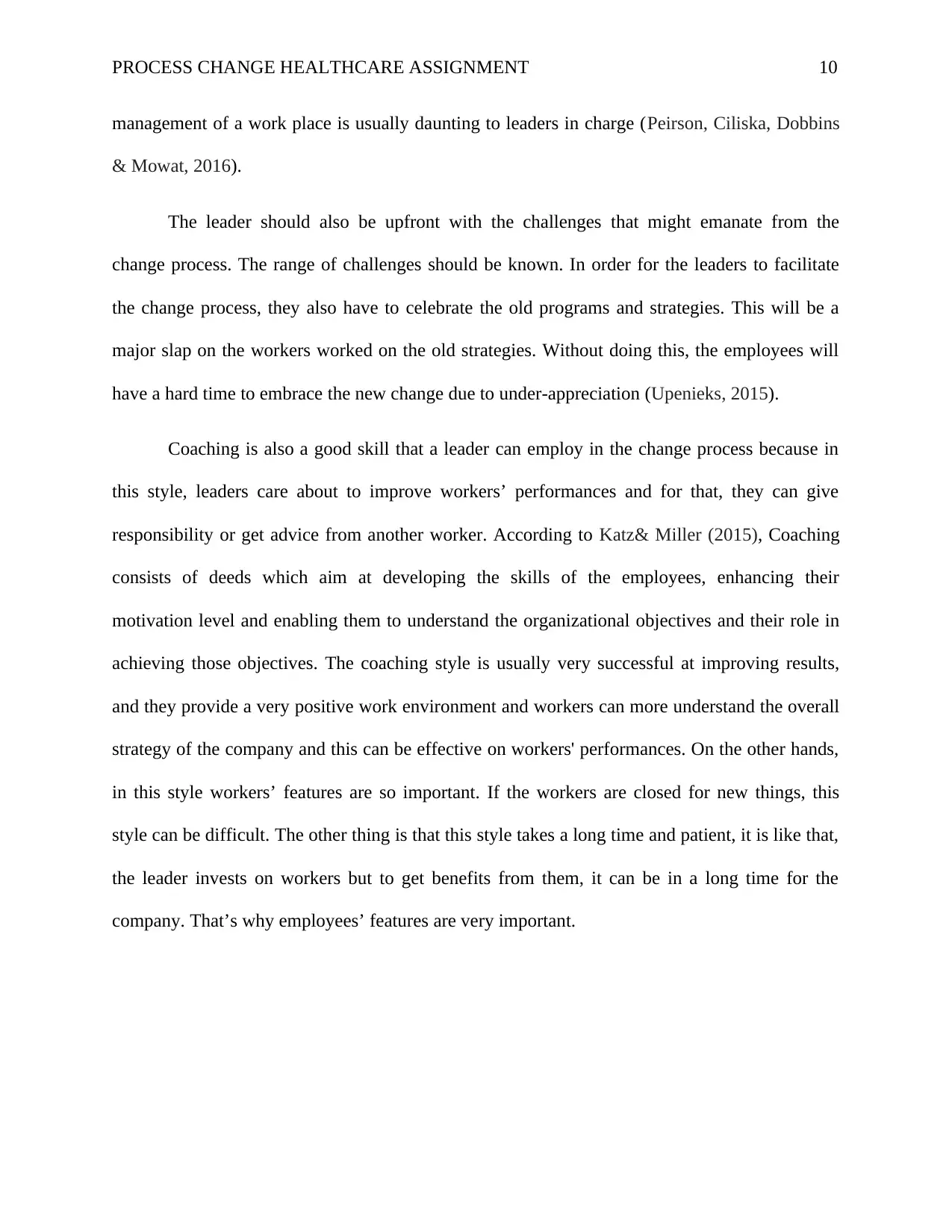
PROCESS CHANGE HEALTHCARE ASSIGNMENT 10
management of a work place is usually daunting to leaders in charge (Peirson, Ciliska, Dobbins
& Mowat, 2016).
The leader should also be upfront with the challenges that might emanate from the
change process. The range of challenges should be known. In order for the leaders to facilitate
the change process, they also have to celebrate the old programs and strategies. This will be a
major slap on the workers worked on the old strategies. Without doing this, the employees will
have a hard time to embrace the new change due to under-appreciation (Upenieks, 2015).
Coaching is also a good skill that a leader can employ in the change process because in
this style, leaders care about to improve workers’ performances and for that, they can give
responsibility or get advice from another worker. According to Katz& Miller (2015), Coaching
consists of deeds which aim at developing the skills of the employees, enhancing their
motivation level and enabling them to understand the organizational objectives and their role in
achieving those objectives. The coaching style is usually very successful at improving results,
and they provide a very positive work environment and workers can more understand the overall
strategy of the company and this can be effective on workers' performances. On the other hands,
in this style workers’ features are so important. If the workers are closed for new things, this
style can be difficult. The other thing is that this style takes a long time and patient, it is like that,
the leader invests on workers but to get benefits from them, it can be in a long time for the
company. That’s why employees’ features are very important.
management of a work place is usually daunting to leaders in charge (Peirson, Ciliska, Dobbins
& Mowat, 2016).
The leader should also be upfront with the challenges that might emanate from the
change process. The range of challenges should be known. In order for the leaders to facilitate
the change process, they also have to celebrate the old programs and strategies. This will be a
major slap on the workers worked on the old strategies. Without doing this, the employees will
have a hard time to embrace the new change due to under-appreciation (Upenieks, 2015).
Coaching is also a good skill that a leader can employ in the change process because in
this style, leaders care about to improve workers’ performances and for that, they can give
responsibility or get advice from another worker. According to Katz& Miller (2015), Coaching
consists of deeds which aim at developing the skills of the employees, enhancing their
motivation level and enabling them to understand the organizational objectives and their role in
achieving those objectives. The coaching style is usually very successful at improving results,
and they provide a very positive work environment and workers can more understand the overall
strategy of the company and this can be effective on workers' performances. On the other hands,
in this style workers’ features are so important. If the workers are closed for new things, this
style can be difficult. The other thing is that this style takes a long time and patient, it is like that,
the leader invests on workers but to get benefits from them, it can be in a long time for the
company. That’s why employees’ features are very important.
Paraphrase This Document
Need a fresh take? Get an instant paraphrase of this document with our AI Paraphraser
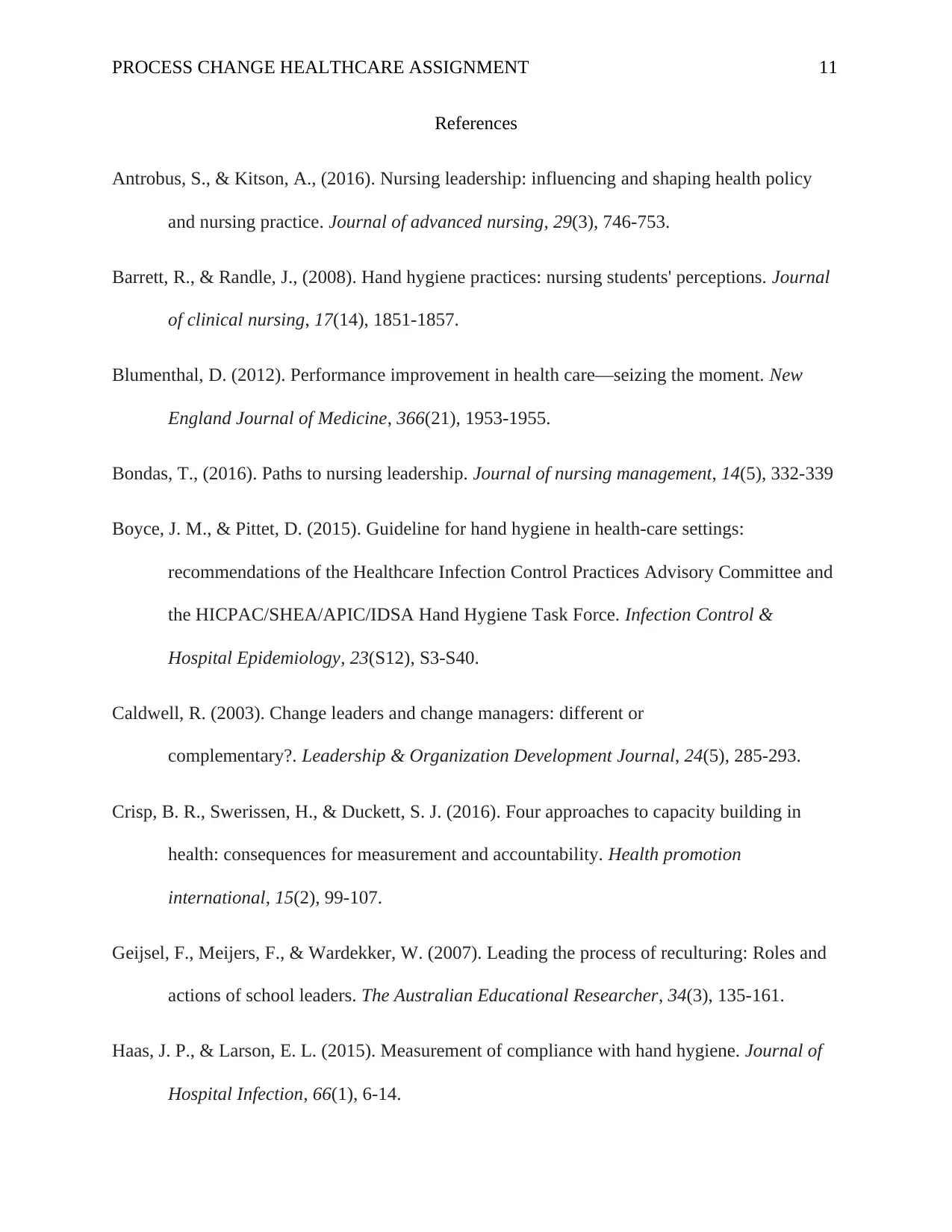
PROCESS CHANGE HEALTHCARE ASSIGNMENT 11
References
Antrobus, S., & Kitson, A., (2016). Nursing leadership: influencing and shaping health policy
and nursing practice. Journal of advanced nursing, 29(3), 746-753.
Barrett, R., & Randle, J., (2008). Hand hygiene practices: nursing students' perceptions. Journal
of clinical nursing, 17(14), 1851-1857.
Blumenthal, D. (2012). Performance improvement in health care—seizing the moment. New
England Journal of Medicine, 366(21), 1953-1955.
Bondas, T., (2016). Paths to nursing leadership. Journal of nursing management, 14(5), 332-339
Boyce, J. M., & Pittet, D. (2015). Guideline for hand hygiene in health-care settings:
recommendations of the Healthcare Infection Control Practices Advisory Committee and
the HICPAC/SHEA/APIC/IDSA Hand Hygiene Task Force. Infection Control &
Hospital Epidemiology, 23(S12), S3-S40.
Caldwell, R. (2003). Change leaders and change managers: different or
complementary?. Leadership & Organization Development Journal, 24(5), 285-293.
Crisp, B. R., Swerissen, H., & Duckett, S. J. (2016). Four approaches to capacity building in
health: consequences for measurement and accountability. Health promotion
international, 15(2), 99-107.
Geijsel, F., Meijers, F., & Wardekker, W. (2007). Leading the process of reculturing: Roles and
actions of school leaders. The Australian Educational Researcher, 34(3), 135-161.
Haas, J. P., & Larson, E. L. (2015). Measurement of compliance with hand hygiene. Journal of
Hospital Infection, 66(1), 6-14.
References
Antrobus, S., & Kitson, A., (2016). Nursing leadership: influencing and shaping health policy
and nursing practice. Journal of advanced nursing, 29(3), 746-753.
Barrett, R., & Randle, J., (2008). Hand hygiene practices: nursing students' perceptions. Journal
of clinical nursing, 17(14), 1851-1857.
Blumenthal, D. (2012). Performance improvement in health care—seizing the moment. New
England Journal of Medicine, 366(21), 1953-1955.
Bondas, T., (2016). Paths to nursing leadership. Journal of nursing management, 14(5), 332-339
Boyce, J. M., & Pittet, D. (2015). Guideline for hand hygiene in health-care settings:
recommendations of the Healthcare Infection Control Practices Advisory Committee and
the HICPAC/SHEA/APIC/IDSA Hand Hygiene Task Force. Infection Control &
Hospital Epidemiology, 23(S12), S3-S40.
Caldwell, R. (2003). Change leaders and change managers: different or
complementary?. Leadership & Organization Development Journal, 24(5), 285-293.
Crisp, B. R., Swerissen, H., & Duckett, S. J. (2016). Four approaches to capacity building in
health: consequences for measurement and accountability. Health promotion
international, 15(2), 99-107.
Geijsel, F., Meijers, F., & Wardekker, W. (2007). Leading the process of reculturing: Roles and
actions of school leaders. The Australian Educational Researcher, 34(3), 135-161.
Haas, J. P., & Larson, E. L. (2015). Measurement of compliance with hand hygiene. Journal of
Hospital Infection, 66(1), 6-14.
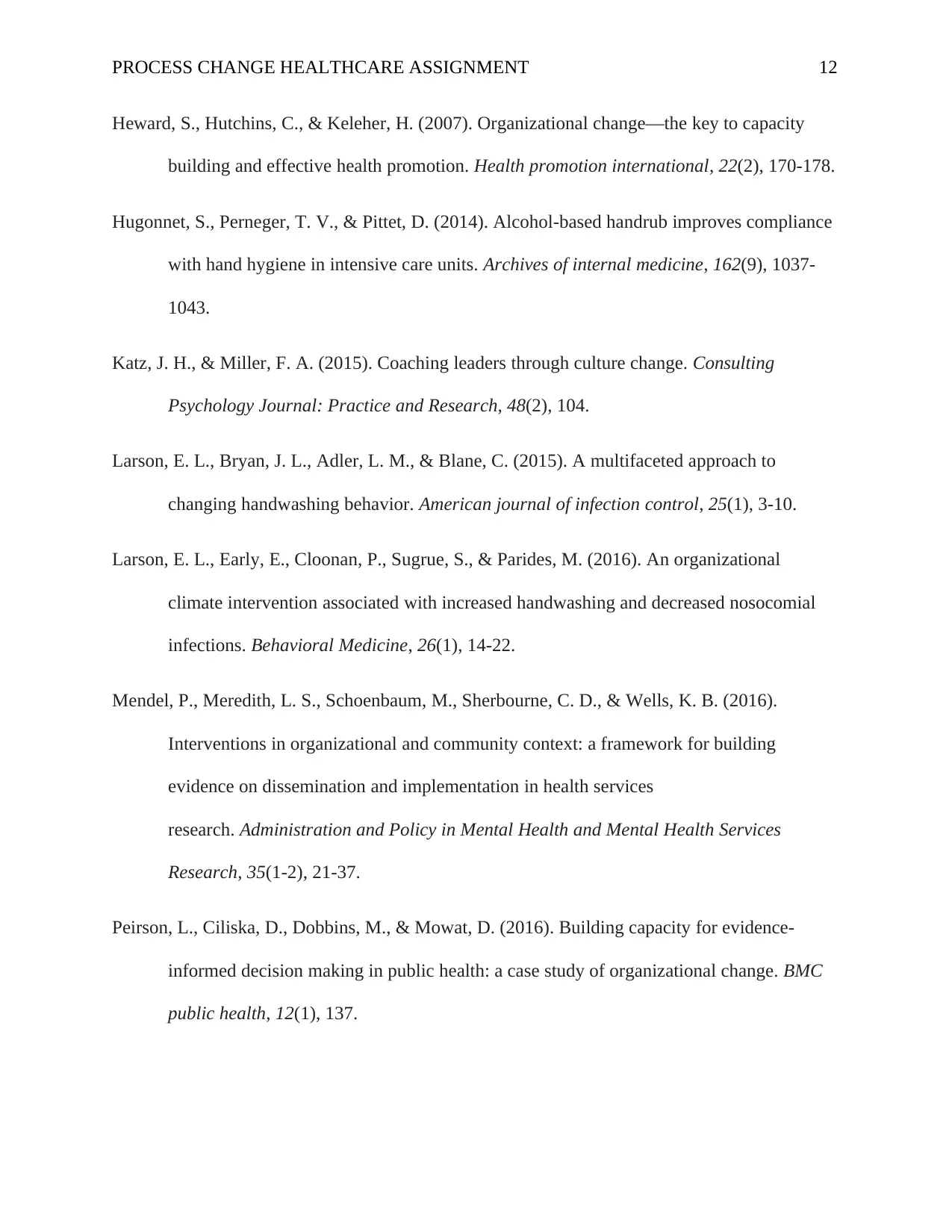
PROCESS CHANGE HEALTHCARE ASSIGNMENT 12
Heward, S., Hutchins, C., & Keleher, H. (2007). Organizational change—the key to capacity
building and effective health promotion. Health promotion international, 22(2), 170-178.
Hugonnet, S., Perneger, T. V., & Pittet, D. (2014). Alcohol-based handrub improves compliance
with hand hygiene in intensive care units. Archives of internal medicine, 162(9), 1037-
1043.
Katz, J. H., & Miller, F. A. (2015). Coaching leaders through culture change. Consulting
Psychology Journal: Practice and Research, 48(2), 104.
Larson, E. L., Bryan, J. L., Adler, L. M., & Blane, C. (2015). A multifaceted approach to
changing handwashing behavior. American journal of infection control, 25(1), 3-10.
Larson, E. L., Early, E., Cloonan, P., Sugrue, S., & Parides, M. (2016). An organizational
climate intervention associated with increased handwashing and decreased nosocomial
infections. Behavioral Medicine, 26(1), 14-22.
Mendel, P., Meredith, L. S., Schoenbaum, M., Sherbourne, C. D., & Wells, K. B. (2016).
Interventions in organizational and community context: a framework for building
evidence on dissemination and implementation in health services
research. Administration and Policy in Mental Health and Mental Health Services
Research, 35(1-2), 21-37.
Peirson, L., Ciliska, D., Dobbins, M., & Mowat, D. (2016). Building capacity for evidence-
informed decision making in public health: a case study of organizational change. BMC
public health, 12(1), 137.
Heward, S., Hutchins, C., & Keleher, H. (2007). Organizational change—the key to capacity
building and effective health promotion. Health promotion international, 22(2), 170-178.
Hugonnet, S., Perneger, T. V., & Pittet, D. (2014). Alcohol-based handrub improves compliance
with hand hygiene in intensive care units. Archives of internal medicine, 162(9), 1037-
1043.
Katz, J. H., & Miller, F. A. (2015). Coaching leaders through culture change. Consulting
Psychology Journal: Practice and Research, 48(2), 104.
Larson, E. L., Bryan, J. L., Adler, L. M., & Blane, C. (2015). A multifaceted approach to
changing handwashing behavior. American journal of infection control, 25(1), 3-10.
Larson, E. L., Early, E., Cloonan, P., Sugrue, S., & Parides, M. (2016). An organizational
climate intervention associated with increased handwashing and decreased nosocomial
infections. Behavioral Medicine, 26(1), 14-22.
Mendel, P., Meredith, L. S., Schoenbaum, M., Sherbourne, C. D., & Wells, K. B. (2016).
Interventions in organizational and community context: a framework for building
evidence on dissemination and implementation in health services
research. Administration and Policy in Mental Health and Mental Health Services
Research, 35(1-2), 21-37.
Peirson, L., Ciliska, D., Dobbins, M., & Mowat, D. (2016). Building capacity for evidence-
informed decision making in public health: a case study of organizational change. BMC
public health, 12(1), 137.
⊘ This is a preview!⊘
Do you want full access?
Subscribe today to unlock all pages.

Trusted by 1+ million students worldwide
1 out of 13
Related Documents
Your All-in-One AI-Powered Toolkit for Academic Success.
+13062052269
info@desklib.com
Available 24*7 on WhatsApp / Email
![[object Object]](/_next/static/media/star-bottom.7253800d.svg)
Unlock your academic potential
Copyright © 2020–2025 A2Z Services. All Rights Reserved. Developed and managed by ZUCOL.





